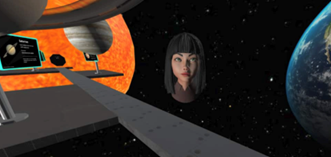Metaverse in Education
)
By Dr Neelam Parmar, Director of Digital Learning and Education, AISL Harrow Schools
The metaverse has generated a lot of buzz and as educators, we know that not all buzz is relevant in our learning spaces. Yet, the article A Whole New World: Education meets the Metaverse highlights new innovations taking shape and we know that an idea can sometimes grow from being a vision to something much greater, particularly if there is enough support to make it into a reality. The way the world has moved in the last two years, this could transpire more quickly than we can imagine.
From one educator to another, what is it about the metaverse that is so exciting? What is its potential within the context of learning in education and can the metaverse afford high value content and quality rich learning experiences for our students within virtual and augmented reality? Moreover, how accessible is to replace the dreaded Teams and Zooms fatigue?
What is the metaverse?
The Metaverse, as defined by Mark Zuckerburg Facebook, is where the physical and digital worlds come together; where individuals take the form as avatars, to interact at work and play. This can include all sorts of immersive virtual and spatial representations such as an online office, live concert or even a shopping mall with AI generated wearable technologies. All this sounds rather exciting but quite frankly, how does this translate in offering new learning gains for our students?
Put simply, the Metaverse is a 3D, fully immersive, global, interconnected, and real-time online spatial event which connects the physical world with possible AR and VR learning experiences. While it is not expected that the Metaverse will replace classroom traditional teaching and learning or even live video conferencing in its entirety, there is potential to integrate the metaverse as an interactive space for students to collaborate, communicate and connect with one another.
How does it work?
Having studied the Metaverse solutions at the UK Bett Show and then again with external providers with a view to explore further for the AISL Harrow Schools group, it appears there are two types of immersive learning solutions; one in which there is a level playing field for all users to access the virtual space via the internet and the second option in which a VR headset is required to capture bespoke AR and VR experiences.
It is rather important to know the difference between these two options as there is a significant reduction of an immersive experience in one type over another. Sadly to say, while we would all like to think that we have come to the days of Star Trek, unfortunately, there are no holodecks- yet!
The first type of immersive learning solution is a mirrored approach of the gaming sector (think Roblox and Minecraft) where individuals, aka students, can enter a common virtual space to freely interact and communicate with one another. This form of immersive learning is directly accessible for everybody, from anywhere in which a virtual space can be accessed via a device. In this context, educators are afforded the opportunity to set up engaging and inspiring 3D based models of virtual classrooms using standard building blocks and tools to create hands-on and experiential forms of learning for students to move, discuss and interact naturally as avatars of their choice. Making the virtual space part of the lesson (e.g. solar system), a teacher can use the immersive environment to discuss, collaborate and explore new learning.
The second type of immersive solution is based on the foundations of a virtual learning experience (as above) where users are equipped with headsets (e.g. Meta Oculus Quest) and/or glasses that allow them to immersive themselves into a realistic virtual world. Using AR and VR technologies, learning can be extended to take into account new transformational learning experiences, where students are given the opportunity to participate in game based or bespoke simulations. For example, through use of various virtual landscapes and 3D object orientation, immersive STEAM led experiences can include examples of ‘how the brain works’ to the study of ‘the water cycle,’ demonstrating conceptual understanding through experiential practice.

Benefits/Challenges
No doubt there are benefits and challenges to the metaverse. One of the biggest benefit to the Metaverse is that it has no geographical barriers (e.g. spatial.io). Therefore, students from all around the world can join a lesson. The metaverse also enables students to get fully immersed in a digital classroom environment where students can physically interact with each other and their instructor, in a space that feels closer than live video conferencing tools. Day to day activities like classes, science experiments or the study of artifacts can happen in real-time, enabling enhanced student participation and presence. The VR headset experience has a huge advantage in that allows for abstract based theoretical and practical knowledge to become conceivable and real.
But like all things, there is a dark side. Cybercrime is a serious issue and as the Metaverse is still in its infancy in the back and beyond, it makes it extremely vulnerable to all sorts of illegal activities such as child exploitation, fraud, cyberattacks, services trafficking etc. to name a few. At present, monitoring within the metaverse is not possible and there does not seem to be an approach to combat its current toxic environment (e.g. VR chat). While there are also concerns that it may addictive in nature, although not entirely convincing, spending too much time within a VR simulated environment can challenge a reality for existence and attachment to take part more in the virtual than the real world. With chosen avatars of their own, mental illness such as depression is a risk to consider for those will join the metaverse and find it better than their real lives. Lastly and probably most importantly, the metaverse requires a fast and reliable internet connection to make it a successful shared virtual environment. Without this, learning will only become inhibited, frustrating for the user and a failed experiment, and most likely, less fortunate communities who do not have access to costly fifth generation wireless network technology, hardware and digital tools will not be able to capitalise and join the learning experience, thereby increasing the already large and wide, inequality gap.
Conclusion
The metaverse has a long way to go before it is fully optimised and secure for our students to navigate freely. While the cons are still a concern, it is still possible to build controlled, independent learning spaces, and there are some schools that have already begun the process. In time, these problematic issues of the metaverse may diminish over time. How we wish to manipulate the metaverse is in the hands of the people, with us as educators, and as long as we find value in the way to optimise new virtual learning spaces to provide for impactful learning outcomes for our students, then we can make the most of the opportunities offered by the virtual world.
Dr. Neelam Parmar, Director of Digital Learning and Education, Asia International School Limited (AISL)
Dr. Neelam Parmar is Director of Digital Learning and Education for AISL. She is an award winning professional, international researcher, author, thought leader and speaker for the use of educational technology, digital pedagogy and innovative curriculum within education. A highly experienced leader in Digital Education, Neelam has engaged with the UK Department of Education (DfE) EdTech Leadership Group, national EdTech Impact workshops, The @womenEd_Tech movement and is also a judge for the global renowned Bett Awards Show.




)
)
)
)
)
)
)
)
)